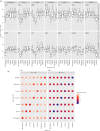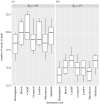A spatial model of COVID-19 transmission in England and Wales: early spread, peak timing and the impact of seasonality
- PMID: 34053261
- PMCID: PMC8165591
- DOI: 10.1098/rstb.2020.0272
A spatial model of COVID-19 transmission in England and Wales: early spread, peak timing and the impact of seasonality
Abstract
An outbreak of a novel coronavirus was first reported in China on 31 December 2019. As of 9 February 2020, cases have been reported in 25 countries, including probable human-to-human transmission in England. We adapted an existing national-scale metapopulation model to capture the spread of COVID-19 in England and Wales. We used 2011 census data to inform population sizes and movements, together with parameter estimates from the outbreak in China. We predict that the epidemic will peak 126 to 147 days (approx. 4 months) after the start of person-to-person transmission in the absence of controls. Assuming biological parameters remain unchanged and transmission persists from February, we expect the peak to occur in June. Starting location and model stochasticity have a minimal impact on peak timing. However, realistic parameter uncertainty leads to peak time estimates ranging from 78 to 241 days following sustained transmission. Seasonal changes in transmission rate can substantially impact the timing and size of the epidemic. We provide initial estimates of the epidemic potential of COVID-19. These results can be refined with more precise parameters. Seasonal changes in transmission could shift the timing of the peak into winter, with important implications for healthcare capacity planning. This article is part of the theme issue 'Modelling that shaped the early COVID-19 pandemic response in the UK.
Keywords: human movement; modelling; seasonality; spatial.
Figures







References
-
- World Health Organization (WHO). 2020. Novel Coronavirus (COVID19) situation report-23. Geneva, Switzerland: WHO.
-
- Imai N, Cori A, Dorigatti I, Baguelin M, Donnelly CA, Riley S, Ferguson NM.. 2020. Report 3: transmissibility of 2019-nCoV. London, UK: Imperial College London.
-
- Liu T, et al. . 2020. Transmission dynamics of 2019 novel coronavirus (2019-nCoV). bioRxiv 2020.01.25.919787. (10.1101/2020.01.25.919787) - DOI
-
- Abbott S, Hellewell J, Munday J, Funk S, Funk S. 2020. The transmissibility of novel Coronavirus in the early stages of the 2019–20 outbreak in Wuhan: exploring initial point-source exposure sizes and durations using scenario analysis. Wellcome Open Res. 5, 17. (10.12688/wellcomeopenres.15718.1) - DOI - PMC - PubMed
Publication types
MeSH terms
Grants and funding
LinkOut - more resources
Full Text Sources
Other Literature Sources
Medical
Research Materials

